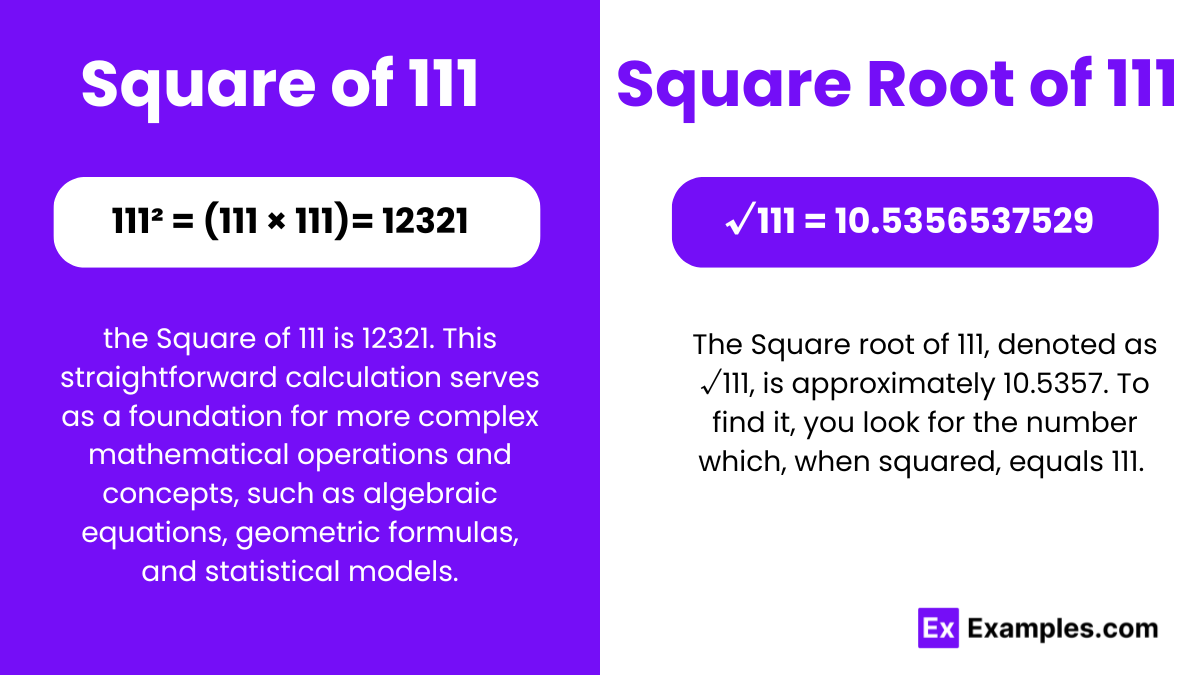What is the square of 111?
12321
10000
22211
12121

the square number of 111 is 12321. This straightforward calculation serves as a foundation for more complex mathematical operations and concepts, such as algebraic equations, geometric formulas, and statistical models.
√111 = 10.5356537529
or
√111 = 10.535 up to three decimals
The square root of 111, denoted as √111, is approximately 10.5357. To find it, you look for the number which, when squared, equals 111. In mathematical terms, finding a square root is about identifying the number that raised to the power of 2 gives back the original number. You can visualize the square root of 111 as the side length of a square that covers an area of 111 square units. Understanding square roots is essential in various math fields and practical applications, such as geometry and algebra, and it’s helpful for calculating actual lengths or measurements from given area values.
Square Root of 111: 10.5356537529
Exponential Form: 111^1/2 or 111^0.5
Radical Form: √111
This means that it cannot be expressed as a simple fraction where both the numerator and the denominator are integers. The decimal form of an irrational number goes on indefinitely without repeating, and this is the case with the square root of 111. Since 111 is not a perfect square (meaning there’s no integer that can be squared to produce 111), its square root cannot be represented as a precise fraction and thus is irrational.
Rational numbers are numbers that you can write as a fraction, with both the top number (numerator) and the bottom number (denominator) being whole numbers. This group includes regular fractions like 1/2, negative fractions like -3/4, whole numbers like 5 (since you can write it as 5/1), and even zero.
Examples: 5/3, -5/2
Irrational numbers, on the other hand, are numbers that you can’t write as a simple fraction. Their decimal forms go on forever without repeating any pattern. These usually include the square roots of numbers that aren’t perfect squares.
Examples: √2, √3,
√111 into a calculator to get an approximate decimal value.SQRT() or something similar) and input 111 to get the result.These methods range from very simple and less precise (estimation) to more complex but highly accurate (Newton’s Method). The choice of method depends on your specific needs and available resources.

By this method, the approximate square root of 111 is 10.5.
A perfect square is an integer that is the square of another integer. For example, 121 is a perfect square because it is 11 squared (11 x 11 = 121). Since there is no integer that when squared gives 111, it cannot be a perfect square. The square root of 111 is an irrational number, approximately 10.5357, further confirming that it is not a perfect square.
The number closest to the square root of 111 is 11. This is because √111 is approximately 10.5357, and the nearest whole number is 11.
The number 111 can be divided by 1, 3, 37, and 111. These numbers are the divisors of 111, meaning they divide it without leaving a remainder.
Various pairs of numbers can be added together to make 111, such as 110 + 1, 100 + 11, 55 + 56, and so forth. In terms of multiplication, 3 × 37 = 111.
The number 111 is not prime because it has divisors other than 1 and itself. A prime number has exactly two distinct positive divisors: 1 and the number itself. For 111, it can be divided by 1, 3, 37, and 111. Therefore, since it has more than two divisors, it is not a prime number.
Text prompt
Add Tone
10 Examples of Public speaking
20 Examples of Gas lighting
What is the square of 111?
12321
10000
22211
12121
Find the square root of 111.
10.54
11.00
10.67
11.23
What is the value of 111 squared?
12321
11111
10101
10000
If x² = 111, what is the approximate value of x?
10.54
11
10.67
11.2
What is the square of 10.67?
111
110
120
100
Find the number whose square is 111
10.67
11.00
10.54
11.23
What is the result when you square the square root of 111?
111
121
100
130
What is 111 divided by its square root?
10.5
11.0
12.0
13.0
Calculate the difference between the square of 111 and 10000.
2321
12321
2121
2211
What is the square root of 12321?
111
121
234
546
Before you leave, take our quick quiz to enhance your learning!

